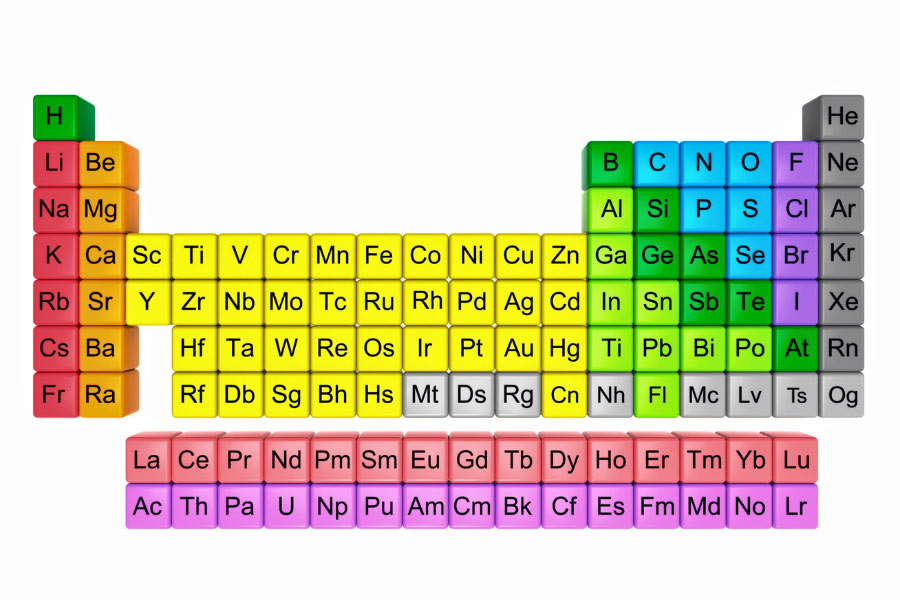
Essential Elements are Critical to Bridging Gaps in Nutrition
Key Takeaways
Executive Summary
The pursuit of an ideal diet has always been at the forefront of human health discussions. Despite the plethora of food options available today, achieving a perfect balance of essential elements remains elusive for many. Our body requires a variety of macro and micro-elements, from foundational ones like carbon and nitrogen to trace ones like iodine and selenium. These elements, vital for various physiological processes, are often overlooked in modern diets.
Common deficiencies observed today include those of magnesium, iron, and zinc, among others. Complicating matters, elemental interactions in our body are intricate, with some elements affecting the absorption or functionality of others, such as the competitive relationship between zinc and copper or the complementary role of calcium and magnesium.
A unique challenge is the ‘Potassium Paradox’. While potassium is vital, there’s a disparity between its content in natural foods and supplements. This discrepancy is rooted in fears of overdose, but it might be time to reevaluate such concerns.
Addressing deficiencies requires a multifaceted approach: understanding bioavailability, balancing elemental interactions, choosing the right supplement form, and valuing whole food sources. As we tread the path of optimal health, it’s crucial to blend traditional dietary wisdom with modern scientific understanding, continually adapting to evolving knowledge and needs.
more from blueripple
How to Increase Your Intake of Antioxidants
Understanding the different kinds of antioxidants is an important part of increasing your intake of antioxidants safely and responsibly.

Introduction
In the vast expanse of human history, the quest for a perfectly balanced diet has always been a topic of discussion and, sometimes, contention. There exists a popular notion that our ancestors, with their natural diets of wild fruits, fresh game, and unprocessed nuts, were the epitome of health and nutrition. This romanticized view paints a picture of early humans strolling through pristine forests, effortlessly obtaining every nutrient they needed. But let’s be realistic; they also faced scarcity, disease, and a lack of knowledge about nutrition.
Fast forward to today: the modern era, where grocery store aisles overflow with a diverse array of foods from around the world. While it’s tempting to believe that a well-rounded modern diet naturally provides all the necessary nutrients, it’s a myth. Several essential elements may still elude us, regardless of how “healthy” we eat. This isn’t a critique of our choices, but rather an exploration of the gaps and how to bridge them.
Elemental Basics: Building Blocks of Our Diet
Our bodies are intricate machines that demand a rich array of elements for optimal function. While some are recognized in daily conversations, others often fly under the radar, even though they’re integral to our well-being.
At the foundation, carbon and nitrogen underpin our very DNA, essential to the molecules that constitute our cells. Calcium, renowned for skeletal strength, collaborates with phosphorus to maintain our bones and teeth. Magnesium aids in muscle function, while sulfur contributes to amino acid formation.
Sodium, potassium, and chlorine are pivotal for maintaining fluid balance and cellular functionality. Iron is central to oxygen transport in our blood; zinc plays a role in immune function; copper and manganese are involved in several enzymatic reactions. Selenium supports our antioxidant defenses, while molybdenum is vital for some essential enzymes.
Trace elements, though required in smaller quantities, remain critical. Silicon aids connective tissue health; fluorine, predominantly as fluoride, fortifies our teeth. Boron has roles in bone health, and chromium impacts metabolism. Cobalt, a component of vitamin B12, is crucial for nerve function, while iodine is indispensable for thyroid hormones.
Rounding off the list, molybdenum aids certain enzymes, and even though its exact role isn’t entirely clear, we consume fluoride for dental health. In totality, our dietary needs span beyond mere calories or popular vitamins; these elements, in the right balance, are the unspoken heroes of our health.
Essential Elements We Need in Our Diet
For optimal health, our bodies rely on a complex interplay of essential elements. From the basic building blocks of life to trace elements that play crucial roles in myriad biochemical reactions, our health hinges on their appropriate intake. Here’s a look at these vital components:
Macro-elements
Oxygen (O) – Though primarily inhaled, we also obtain it from certain foods and water.
Carbon (C) – Found in every organic molecule in our foods – from carbs to fats.
Nitrogen (N) – Essential component of amino acids in proteins.
Calcium (Ca) – 1.0 g daily; pivotal for bone health and nerve function.
Phosphorus (P) – 0.78 g; a vital part of DNA and energy molecules.
Potassium (K) – 2.0 mg; for nerve and muscle function.
Sulfur (S) – 0.14 g; a component of certain amino acids.
Micro-elements
These are required in smaller amounts but are no less important.
Sodium (Na), Chlorine (Cl), Magnesium (Mg), Iron (Fe), Zinc (Zn), Copper (Cu), and others in the list function in various capacities, from electrolyte balance to enzyme function.
It’s paramount to understand the distinction between macro and micro elemental needs. While we require more of the macro-elements, the micro-elements, though needed in trace amounts, are vital for various physiological processes. A deficiency or an excess of even these tiny amounts can disrupt our body’s equilibrium. Hence, balance is the key.
Common Deficiencies in the Modern Diet
Modern lifestyles and dietary habits have led to several elemental deficiencies, significantly impacting our health:
Magnesium. Many are unaware of its crucial role in over 300 biochemical reactions. Deficiency can lead to muscle cramps, fatigue, and irregular heart rhythms. Processed foods and soil depletion are key culprits.
Iron. Iron-deficiency anemia is widespread, causing fatigue, weakness, and pallor. Women, particularly those pregnant, are at a heightened risk.
Zinc. Critical for immune function and wound healing, yet many face absorption challenges. Dietary habits and regional food sources play roles in its scarcity.
Iodine. Essential for thyroid hormone production, a deficiency can cause goiter and developmental issues. Despite salt iodization campaigns, global concerns persist.
Calcium. Beyond just bones, calcium is vital for muscle function. Dairy avoidance and vitamin D deficiency exacerbate its lack.
Vitamin B12 and Cobalt. Inextricably linked, B12 deficiency, prevalent among vegans and vegetarians, can lead to nerve damage and anemia.
Vitamin B12 and Cobalt. Inextricably linked, B12 deficiency, prevalent among vegans and vegetarians, can lead to nerve damage and anemia.
Selenium. Its availability is dictated by regional soil concentrations. Low selenium can impair immune and thyroid function.
Potassium. Modern processed diets are high in sodium but lack potassium, upsetting our electrolyte balance, which can lead to hypertension.
Chromium. Lesser-known but essential for metabolizing carbohydrates and lipids. Its deficiency can impact insulin function.
Each deficiency underscores the importance of a balanced, varied diet, aware of the nuances of nutritional needs.
The Delicate Dance: Elemental Interactions
The body’s intricate dance with elements isn’t as straightforward as intake and utilization. Some elements, while essential, vie for the same absorption pathways or affect one another’s functionality:
Zinc and Copper. These trace elements compete for absorption. An excessive intake of one can inhibit the other, impacting immune function and antioxidant defenses.
Calcium and Magnesium. They’re collaborators, with both playing pivotal roles in muscle contraction and nerve transmission. A balance between them ensures optimal function.
Calcium and Iron. Calcium can inhibit iron absorption, particularly non-heme iron from plant sources, affecting energy and oxygen transport.
Sodium and Potassium. These are crucial electrolytes, ensuring cellular function and fluid balance. An imbalance can lead to cardiac and neural complications.
Iodine and Selenium. Both are indispensable for thyroid health. While iodine is required for hormone synthesis, selenium aids its conversion to active forms.
Iron and Zinc. Non-animal sources of these minerals can create a competitive tug-of-war for absorption, emphasizing the need for dietary diversification.
These interactions highlight the complexity of our nutritional needs and the delicacy of maintaining equilibrium.
The Potassium Paradox
Potassium plays a crucial role in our health, vital for proper nerve function, muscle contraction, and maintaining our electrolyte balance. Despite its importance, there’s a noticeable disparity in the potassium content when comparing supplements to natural food sources like bananas and orange juice.
One might wonder why supplements are so conservative with their potassium content. The commonly accepted belief is the risk of hyperkalemia, a condition where excessive potassium can disturb the heart’s rhythm. However, there’s growing sentiment that this fear is overly cautious, leading many to the conclusion that moderate supplementation might be not just safe, but beneficial.
Natural foods have the advantage of offering a balanced matrix of minerals, making overdose unlikely. But for those who can’t always consume potassium-rich foods, supplements could bridge the gap. It’s essential to approach potassium supplementation with balance and knowledge, valuing both nature’s offerings and the benefits of science.
Overcoming Elemental Deficiencies
In the journey of optimal health, addressing elemental deficiencies is paramount. However, merely popping a supplement isn’t enough; it requires an intelligent approach.
Ensuring Bioavailability. It’s not about how much you take, but how much your body can use. Some minerals are better absorbed in specific forms. For instance, magnesium citrate is often touted as being more bioavailable than its oxide counterpart.
Balancing Elemental Interactions. As previously discussed, elements can compete or complement each other. For example, while calcium and magnesium work together for muscle function, they can compete for absorption. Ensuring a balanced intake is key.
Choosing the Right Form. Supplements come in various forms – powders, capsules, or tablets. Powders often offer flexibility in dosing and might be absorbed faster, but tablets might be more convenient for some.
Whole Food Sources. Mother Nature often knows best. Whole foods not only provide the elemental nutrition but also bring along other beneficial compounds that promote better absorption and synergy. Think of it as nature’s well-balanced meal.
Varied Diets. It’s tempting to stick to our favorite foods, but variety is more than just the spice of life. Incorporating a diverse range of fruits, vegetables, nuts, and other foods ensures a broad spectrum of minerals and reduces the risk of singular deficiencies.
In essence, overcoming deficiencies requires a holistic approach, blending the precision of supplementation with the natural bounty of our diets.
“An ounce of prevention is worth a pound of cure.” — Benjamin Franklin
Conclusion
The modern diet, rich with options and backed by science, holds immense potential to cater to our nuanced elemental needs. As we stand at the intersection of traditional wisdom and scientific advancements, we have the tools and knowledge to make informed choices that benefit our health.
However, with great knowledge comes great responsibility. It’s not merely about adding supplements or eating specific foods but about understanding the intricate dance of elements in our body. The advancements in our understanding of nutrition empower us to tap into the best of both worlds: the natural nourishment from whole foods and the precision of supplements.
Yet, it’s essential to remember that this journey of understanding our nutritional needs is continuous. Our bodies are dynamic, and our environment constantly changes. But with a commitment to learning and adapting, we can harness the potential of the modern diet to its fullest.
In conclusion, the path to optimal health is an ongoing exploration, filled with discoveries and adjustments. By staying informed and receptive, we ensure that every step we take is a step toward a healthier future.
